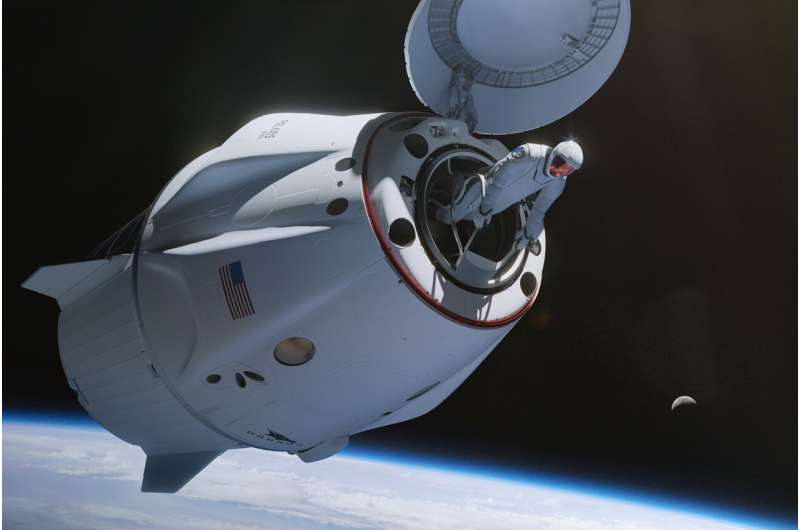Debris from NASA's DART Mission Could Potentially Reach Earth and Mars
Wednesday, 11 September 2024 16:04 NASA's Double Asteroid Redirect Test (DART) mission, which struck the asteroid Dimorphos in 2022, has not only altered the asteroid's orbit but has also created a plume of debris that may eventually reach both Earth and Mars, according to new simulations. The debris, although harmless, could potentially be observed as meteors.
On September 26, 2022, NASA's DART spacecraft, weighing approxi
NASA's Double Asteroid Redirect Test (DART) mission, which struck the asteroid Dimorphos in 2022, has not only altered the asteroid's orbit but has also created a plume of debris that may eventually reach both Earth and Mars, according to new simulations. The debris, although harmless, could potentially be observed as meteors.
On September 26, 2022, NASA's DART spacecraft, weighing approxi Keeping the cosmos clean
Wednesday, 11 September 2024 16:04 Asked to describe his work for a lay audience, Allan Shtofenmakher responds with an unexpected question: "Have you ever seen the movie 'Wall-E?'" Recalling that the 2008 Disney-Pixar movie's view of Earth from space was "brown and dusty and just surrounded by tons and tons of space junk," he cautions, "If we're not good stewards of our local space environment, we could actually end up in a situa
Asked to describe his work for a lay audience, Allan Shtofenmakher responds with an unexpected question: "Have you ever seen the movie 'Wall-E?'" Recalling that the 2008 Disney-Pixar movie's view of Earth from space was "brown and dusty and just surrounded by tons and tons of space junk," he cautions, "If we're not good stewards of our local space environment, we could actually end up in a situa First Metal Part 3D Printed in Space Aboard ISS
Wednesday, 11 September 2024 16:04 ESA's Metal 3D Printer has successfully produced the first-ever metal part in space. This technological milestone, achieved through a partnership with Airbus, marks a significant advancement in additive manufacturing in microgravity.
The Metal 3D Printer was launched to the International Space Station (ISS) earlier this year. ESA astronaut Andreas Mogensen was responsible for installing th
ESA's Metal 3D Printer has successfully produced the first-ever metal part in space. This technological milestone, achieved through a partnership with Airbus, marks a significant advancement in additive manufacturing in microgravity.
The Metal 3D Printer was launched to the International Space Station (ISS) earlier this year. ESA astronaut Andreas Mogensen was responsible for installing th ChemCam Laser Hits 1 Million Zaps on Mars, Continues Data Collection
Wednesday, 11 September 2024 16:04 The ChemCam instrument, developed by Los Alamos National Laboratory, has fired its laser for the 1 millionth time on Mars. Positioned atop NASA's Curiosity rover, ChemCam has been key to scientific discoveries since its deployment in 2012.
"Not only is this a remarkable technical accomplishment for our instrument, but it also represents a staggering amount of chemistry data from the surfac
The ChemCam instrument, developed by Los Alamos National Laboratory, has fired its laser for the 1 millionth time on Mars. Positioned atop NASA's Curiosity rover, ChemCam has been key to scientific discoveries since its deployment in 2012.
"Not only is this a remarkable technical accomplishment for our instrument, but it also represents a staggering amount of chemistry data from the surfac Antarctic research supports healthy space for astronauts
Wednesday, 11 September 2024 16:04
Astronauts and Australian Antarctic expeditioners are working together to advance human health in space, and on Earth.
Today, four astronauts are orbiting Earth on the Polaris Dawn mission, undertaking a range of research projects to better understand the effects of long-duration spaceflight on human health.
At the same time, expeditioners and doctors at Australia's Antarctic and sub-Antarctic stations are collecting data for two of the projects, involving ultrasound and body scanning technology.
Australian Antarctic Division Chief Medical Officer, Dr. Jeff Ayton, said the two projects were part of a collaboration with the US-based Translational Research Institute for Space Health (TRISH).
"Antarctic expeditioners and astronauts are both isolated, confined populations in extreme environments, doing hazardous work, dependent on technology for survival, and with limited scope for evacuation," he said.
"This makes Australia's Antarctic Program an excellent analog for understanding the risks to humans in space, and for testing and developing technologies and methodologies to reduce these risks.
Keeping mold out of future space stations
Wednesday, 11 September 2024 16:02
Mold can survive the harshest of environments, so to stop harmful spores from growing on future space stations, a new study suggests a novel way to prevent its spread.
Spacewalking is the new domain of the rich as billionaire attempts first private spacewalk
Wednesday, 11 September 2024 13:48
First came space tourism. Now comes an even bigger thrill for the monied masses: spacewalking.
The stage is set for the first private spacewalk Thursday. Tech billionaire Jared Isaacman will pop out of the hatch of his orbiting SpaceX capsule, two days after blasting off from Florida on a chartered flight that lifted him and his crew higher than anyone since NASA's moonwalkers. He partnered with SpaceX CEO Elon Musk to buy a series of rocket rides and help develop brand new spacesuits.
SpaceX is the first private company to attempt a spacewalk, until now the domain of just 12 countries. There's a reason why it's such a niche and elite group: Spacewalking is considered the most dangerous part of any flight after launch and reentry, and demands extensive training.
Hera CubeSats’ touchdown
Wednesday, 11 September 2024 12:22 Image:
Hera CubeSats’ touchdown
Image:
Hera CubeSats’ touchdown U.S. space weather policy is alive and well but is insufficiently funded
Wednesday, 11 September 2024 12:00
Private astronauts on daring trek ahead of historic spacewalk
Wednesday, 11 September 2024 11:56 A private crew set out on an audacious orbital expedition Tuesday, journeying deeper into the cosmos than any humans in half a century as they prepare for the first ever spacewalk by non-professional astronauts.
The SpaceX Polaris Dawn mission, led by Shift4 Payments CEO Jared Isaacman, launched from the Kennedy Space Center in Florida and should by the end of its first day attain a peak alt
A private crew set out on an audacious orbital expedition Tuesday, journeying deeper into the cosmos than any humans in half a century as they prepare for the first ever spacewalk by non-professional astronauts.
The SpaceX Polaris Dawn mission, led by Shift4 Payments CEO Jared Isaacman, launched from the Kennedy Space Center in Florida and should by the end of its first day attain a peak alt What's it Like to Spacewalk?
Wednesday, 11 September 2024 11:56 Spacewalks occur in the vacuum of deep space, but astronauts are tethered to their spacecraft if they exit an orbiting space station, space module, or spacecraft. Inside a spaceship, conditions are well suited to humans. Outside, in space, it's an entirely different story. The frigid vacuum of space presents deadly risks.
Spacewalks occur in the vacuum of deep space, but astronauts are tethered to their spacecraft if they exit an orbiting space station, space module, or spacecraft. Inside a spaceship, conditions are well suited to humans. Outside, in space, it's an entirely different story. The frigid vacuum of space presents deadly risks. Earth scientists take flight, set sail to verify PACE satellite data
Wednesday, 11 September 2024 11:56 From sea to sky to orbit, a range of vantage points allow NASA Earth scientists to collect different types of data to better understand our changing planet. Collecting them together, at the same place and the same time, is an important step used to verify the accuracy of satellite data.
NASA's Plankton, Aerosol, Cloud, ocean Ecosystem (PACE) satellite launched in February 2024 and is colle
From sea to sky to orbit, a range of vantage points allow NASA Earth scientists to collect different types of data to better understand our changing planet. Collecting them together, at the same place and the same time, is an important step used to verify the accuracy of satellite data.
NASA's Plankton, Aerosol, Cloud, ocean Ecosystem (PACE) satellite launched in February 2024 and is colle Astroscale and ClearSpace get funds to advance double satellite de-orbit mission
Wednesday, 11 September 2024 10:56

Amid Boeing's Starliner troubles, WA space industry thrives
Wednesday, 11 September 2024 10:47
It'd be reasonable to think Washington's space economy has a lot riding on Boeing's Starliner, the spacecraft that left two astronauts stranded on the International Space Station and headed back to Earth with an empty cabin Friday.
The astronauts were scheduled to return on Starliner in June after a week on the ISS, but thruster failures and helium leaks on the way there made NASA decide a trip back on the Boeing spacecraft was too risky. Boeing's troubles with Starliner date back years, including a flawed, unmanned test flight in 2019 that had to be repeated in 2022.
But, outside of some classified satellite jobs that pop up in South King County, Boeing's efforts in the Seattle area are largely centered on its commercial airplane business, according to industry experts. Instead, the biggest players in the Seattle area's space industry are Amazon, Blue Origin and SpaceX.
"The Seattle space ecosystem is small but mighty because we have companies here that cover the entire space supply chain," said Stan Shull, founder of space technology consulting firm Alliance Victory.
Shull said there are the space and tech giants like SpaceX and Amazon manufacturing thousands of satellites in their Starlink and Project Kuiper divisions, respectively, and Blue Origin with its rocket engines and spacecraft.


